Catholic Virtues
 |
 |
 |
 |
 |
 |
 |
True & False Paths to Happiness - XXXV
A Transcendent Vision of Reality:
The Transphere
When a person looks at a certain thing, he can form in his mind an idea of what that thing would be like if it had an excellence that lies within the confines of the imaginable. The greater the person's innocence, the richer and more defined this idea would be.
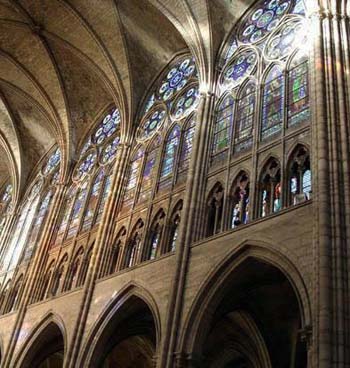 Thus, looking at an arch atop a door, one can have a very fine visualization of that arch, forming the idea of what the “arch of all arches” should be. And, based on this notion of the model ideal of an arch, he will judge that arch and decides whether he likes it or not.
Thus, looking at an arch atop a door, one can have a very fine visualization of that arch, forming the idea of what the “arch of all arches” should be. And, based on this notion of the model ideal of an arch, he will judge that arch and decides whether he likes it or not.
This notion of the “arch of all arches” is formed through the senses and in some way is alive in the person. And this causes him to have with regard to almost everything a fecundity in forming ideal notions, very subconscious, but very real.
And to the measure that the person comes to know this universe, the idea of an ideal universe is born. He knows that this ideal universe as he imagines it does not exist, but he senses that it is something that in some way should exist.
This vision of a model ideal corresponds to, which we will now analyze.
Goethe & Strasbourg Cathedral
This exercise of the mind described above is not as unusual as it might appear at first sight. Some famous personages have even made it explicit.
For example, in his memoirs Goethe (1749-1832) describes how, during a visit to Strasbourg, he used to study the tower of its cathedral and found something missing. After much analysis, he came to the conclusion that there should be four turrets placed on the corners of the tower for it to be more beautiful.
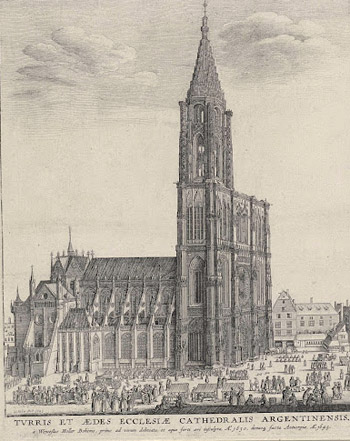 During that same stay in Strasbourg, he was invited to a social gathering in a countryside home where the group could see the front of the cathedral and the tower that rose majestically over it.
During that same stay in Strasbourg, he was invited to a social gathering in a countryside home where the group could see the front of the cathedral and the tower that rose majestically over it.
In the course of the conversation about that marvelous view, he commented that the tower could not be fully appreciated because it should have four slender turrets to complete it, and he described how he conceived them.
Hearing this, a lively little man turned to him and said, "Who told you that?"
He replied that he had studied the tower so often and with such attention and veneration that one day the tower itself had confessed to him what it needed to be fully complete.
Then the little man replied: "She informed you correctly! I know this very well, for I am the curator of the Cathedral Museum. I have the original plan in my files and it confirms what you say exactly. If you like, stop by tomorrow and I will show you the plan."
The cone of Mount Fujiyama
Let us go to another very beautiful example, which is that of Mount Fujiyama. One has the impression that it was rising up to reach a sharp point, and that then there was some geophysical phenomenon that stopped that point from being completed. However, that point is somewhat insinuated, so you can perceive how it could be. And the charm of Fujiyama lies in not having that sharp point that you can only imagine.
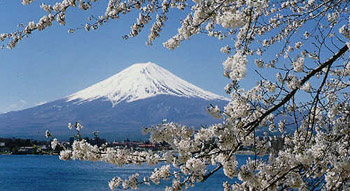 If someone were to take a drawing representing Fujiyama and try to complete the cone by sketching it in, he would not be able to make a perfect cone that would have all the beauty of Fujiyama.
If someone were to take a drawing representing Fujiyama and try to complete the cone by sketching it in, he would not be able to make a perfect cone that would have all the beauty of Fujiyama.
That is to say, one can perceive that it would be possible to have that cone, but it would not be like any of the ones drawn. There is only an insinuation of what it should be. There is something of a metaphysical knowledge, which is more of a negation, that says: “This is not the cone, it is not that one, nor the next one.” There is an idea of what the perfect cone would look like, but it is doubtful that anyone would be able to make that peak as it should be. The exhilarating side of Fujiyama, in my opinion, lies in this.
Notwithstanding, imagine that an artist managed to compose the perfect peak of Fujiyama in a painting or drawing. The mountain would be fully itself because the artist would have added the peak, but it would only have reached its plenitude because that peak was conceived in the artist's head.
The artist who could complete Fujiyama with its proper peak, in such a way that it does not lose any of its beauty, would have communicated to the mountain something of his genius as an artist. And Fujiyama would, so to speak, come alive and acquire a soul by the fact it received from the artist a complement that it, Fujiyama, does not have.
The mind of man should dwell in the ‘Fujiyama cone’ of all things
Thus, the most beautiful cone in the world is a cone that does not exist. It exists only in a kind of ethereal and undefined sphere, in which all the beauties of Fujiyama and of all cones are concentrated.
It is in this zone of reality that a man's mind should dwell in order to draw closer to God. He should feel like an exile every time he has to descend into the concrete, because the concrete is not the height of reality.
The summit of reality is that ethereal sphere in which we place, as possibles existing in the Divine Mind, the cone and things like it. When your mind dwells in this place, then it is possible to treat everything that takes place on the solid earth as small things viewed from a higher sphere of reality, which little by little we define.
Notre-Dame: the towers no one dared to complete
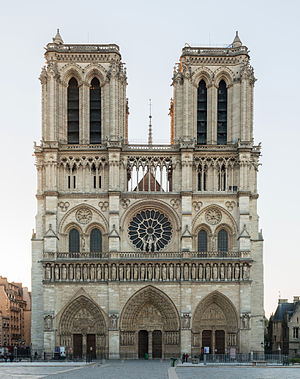
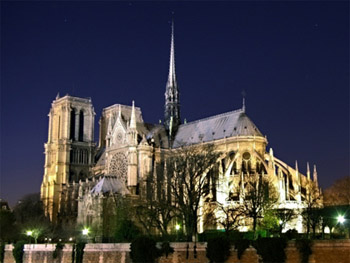 Another well-known case is that of the towers of Notre-Dame. It is an acknowledged fact that they were not finished. It is so beautiful that, on the one hand, one can think that there was no need for anything else to placed on it. But the architect intended to complete it, only the plans were lost.
Another well-known case is that of the towers of Notre-Dame. It is an acknowledged fact that they were not finished. It is so beautiful that, on the one hand, one can think that there was no need for anything else to placed on it. But the architect intended to complete it, only the plans were lost.
After you know that the towers of Notre-Dame were not completed, you keep looking and looking at them...
The edifice tells us something about those towers that do not exist, but nothing we imagine satisfies us because of a model that exists only in the shadows of our mind and enthuses us. This enthusiasm for what we know only in a negative way gives us something of the spark of the absolute.
No matter how hard one tries to complete the towers of Notre-Dame – perhaps a great architect could do it – no satisfactory solution is reached. That is to say, as a negation, one can have a certain notion of the towers that could be placed there.
What Goethe did with the towers of Strasbourg Cathedral he could not do with Notre-Dame, and still less with the cone of Fujiyama. The thing about Notre-Dame Cathedral that delights me, subjugates me and overwhelms me is that it is so beautiful just as it is that one would say that nothing more could be added.
Well, if fact there was supposed to be more! Therefore, that addition has to have a beauty that would be the opposite, in a non-Greek line, of what those truncated towers have in a classical, almost Greek line. Whoever could do this would merit an award.
The French architect Viollet-le-Duc made made something like a small stitch with the needle behind the cathedral, which he restored and made higher. He did not dare, however, to complete the front towers…
Mont Saint-Michel transmits a spark of the absolute
Where I believe Viollet-le-Duc hit the mark was with the abbey of Mont Saint-Michel. In my view, that was the the stroke of genius in his life. He found the “Fujiyama cone” of Mont Saint-Michel. And the whole world, going there, sees the needle that Viollet-le-Duc placed atop it, much more than that mountain of stones.
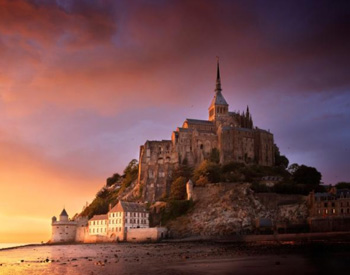 Looking at a photo of Mont Saint-Michel, it is impossible not to feel enthusiasm for that arrow on the Abbey. Without that arrow, the conjunct loses a great deal. It is not the same for the Cathedral of Notre-Dame, where every part is beautiful. In Mont Saint-Michel, no: it is beautiful only because Viollet-le-Duc – a great specialist in things of the Middle Ages – knew how to erect that central tower, with that arrow, which gave a wonderful unity to that dispersive construction and thus made it the point of attraction for tourists from around the world.
Looking at a photo of Mont Saint-Michel, it is impossible not to feel enthusiasm for that arrow on the Abbey. Without that arrow, the conjunct loses a great deal. It is not the same for the Cathedral of Notre-Dame, where every part is beautiful. In Mont Saint-Michel, no: it is beautiful only because Viollet-le-Duc – a great specialist in things of the Middle Ages – knew how to erect that central tower, with that arrow, which gave a wonderful unity to that dispersive construction and thus made it the point of attraction for tourists from around the world.
Where is the spark of the absolute there? A keen observer perceives that the whole edifice tends toward that unum, and the building is beautiful because of that unum. And that unum seems to detach itself from the earth and enter the heavens above. Upward, upward… ending in an arrow so fine that it gives the impression that it dissolves in the air and reaches God.
It is, therefore, something so beautiful that, because it has a certain analogy with the beauties of God, in it one sees God. This sensation of the absolute is a spark of the absolute.
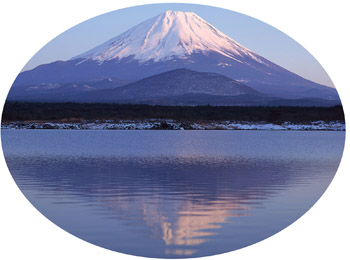
Continued


The arches of the Basilica of St. Denis in France
This notion of the “arch of all arches” is formed through the senses and in some way is alive in the person. And this causes him to have with regard to almost everything a fecundity in forming ideal notions, very subconscious, but very real.
And to the measure that the person comes to know this universe, the idea of an ideal universe is born. He knows that this ideal universe as he imagines it does not exist, but he senses that it is something that in some way should exist.
This vision of a model ideal corresponds to, which we will now analyze.
Goethe & Strasbourg Cathedral
This exercise of the mind described above is not as unusual as it might appear at first sight. Some famous personages have even made it explicit.
For example, in his memoirs Goethe (1749-1832) describes how, during a visit to Strasbourg, he used to study the tower of its cathedral and found something missing. After much analysis, he came to the conclusion that there should be four turrets placed on the corners of the tower for it to be more beautiful.

Goethe realized that four turrets were missing in the Strasbourg Cathedral tower
In the course of the conversation about that marvelous view, he commented that the tower could not be fully appreciated because it should have four slender turrets to complete it, and he described how he conceived them.
Hearing this, a lively little man turned to him and said, "Who told you that?"
He replied that he had studied the tower so often and with such attention and veneration that one day the tower itself had confessed to him what it needed to be fully complete.
Then the little man replied: "She informed you correctly! I know this very well, for I am the curator of the Cathedral Museum. I have the original plan in my files and it confirms what you say exactly. If you like, stop by tomorrow and I will show you the plan."
The cone of Mount Fujiyama
Let us go to another very beautiful example, which is that of Mount Fujiyama. One has the impression that it was rising up to reach a sharp point, and that then there was some geophysical phenomenon that stopped that point from being completed. However, that point is somewhat insinuated, so you can perceive how it could be. And the charm of Fujiyama lies in not having that sharp point that you can only imagine.

An unfinished peak that no one knows how to complete
That is to say, one can perceive that it would be possible to have that cone, but it would not be like any of the ones drawn. There is only an insinuation of what it should be. There is something of a metaphysical knowledge, which is more of a negation, that says: “This is not the cone, it is not that one, nor the next one.” There is an idea of what the perfect cone would look like, but it is doubtful that anyone would be able to make that peak as it should be. The exhilarating side of Fujiyama, in my opinion, lies in this.
Notwithstanding, imagine that an artist managed to compose the perfect peak of Fujiyama in a painting or drawing. The mountain would be fully itself because the artist would have added the peak, but it would only have reached its plenitude because that peak was conceived in the artist's head.
The artist who could complete Fujiyama with its proper peak, in such a way that it does not lose any of its beauty, would have communicated to the mountain something of his genius as an artist. And Fujiyama would, so to speak, come alive and acquire a soul by the fact it received from the artist a complement that it, Fujiyama, does not have.
The mind of man should dwell in the ‘Fujiyama cone’ of all things
Thus, the most beautiful cone in the world is a cone that does not exist. It exists only in a kind of ethereal and undefined sphere, in which all the beauties of Fujiyama and of all cones are concentrated.
It is in this zone of reality that a man's mind should dwell in order to draw closer to God. He should feel like an exile every time he has to descend into the concrete, because the concrete is not the height of reality.
The summit of reality is that ethereal sphere in which we place, as possibles existing in the Divine Mind, the cone and things like it. When your mind dwells in this place, then it is possible to treat everything that takes place on the solid earth as small things viewed from a higher sphere of reality, which little by little we define.
Notre-Dame: the towers no one dared to complete

At the exact moment Our Lady conceived the Savior in her mind, the Archangel appeared

After you know that the towers of Notre-Dame were not completed, you keep looking and looking at them...
The edifice tells us something about those towers that do not exist, but nothing we imagine satisfies us because of a model that exists only in the shadows of our mind and enthuses us. This enthusiasm for what we know only in a negative way gives us something of the spark of the absolute.
No matter how hard one tries to complete the towers of Notre-Dame – perhaps a great architect could do it – no satisfactory solution is reached. That is to say, as a negation, one can have a certain notion of the towers that could be placed there.
What Goethe did with the towers of Strasbourg Cathedral he could not do with Notre-Dame, and still less with the cone of Fujiyama. The thing about Notre-Dame Cathedral that delights me, subjugates me and overwhelms me is that it is so beautiful just as it is that one would say that nothing more could be added.
Well, if fact there was supposed to be more! Therefore, that addition has to have a beauty that would be the opposite, in a non-Greek line, of what those truncated towers have in a classical, almost Greek line. Whoever could do this would merit an award.
The French architect Viollet-le-Duc made made something like a small stitch with the needle behind the cathedral, which he restored and made higher. He did not dare, however, to complete the front towers…
Mont Saint-Michel transmits a spark of the absolute
Where I believe Viollet-le-Duc hit the mark was with the abbey of Mont Saint-Michel. In my view, that was the the stroke of genius in his life. He found the “Fujiyama cone” of Mont Saint-Michel. And the whole world, going there, sees the needle that Viollet-le-Duc placed atop it, much more than that mountain of stones.

Where is the spark of the absolute there? A keen observer perceives that the whole edifice tends toward that unum, and the building is beautiful because of that unum. And that unum seems to detach itself from the earth and enter the heavens above. Upward, upward… ending in an arrow so fine that it gives the impression that it dissolves in the air and reaches God.
It is, therefore, something so beautiful that, because it has a certain analogy with the beauties of God, in it one sees God. This sensation of the absolute is a spark of the absolute.

Continued

Posted November 8, 2021





